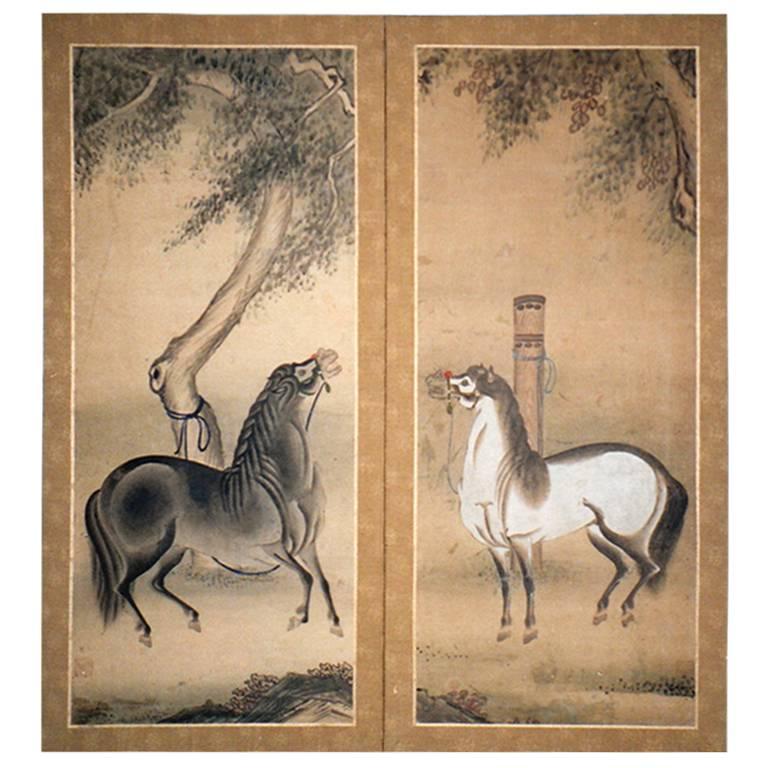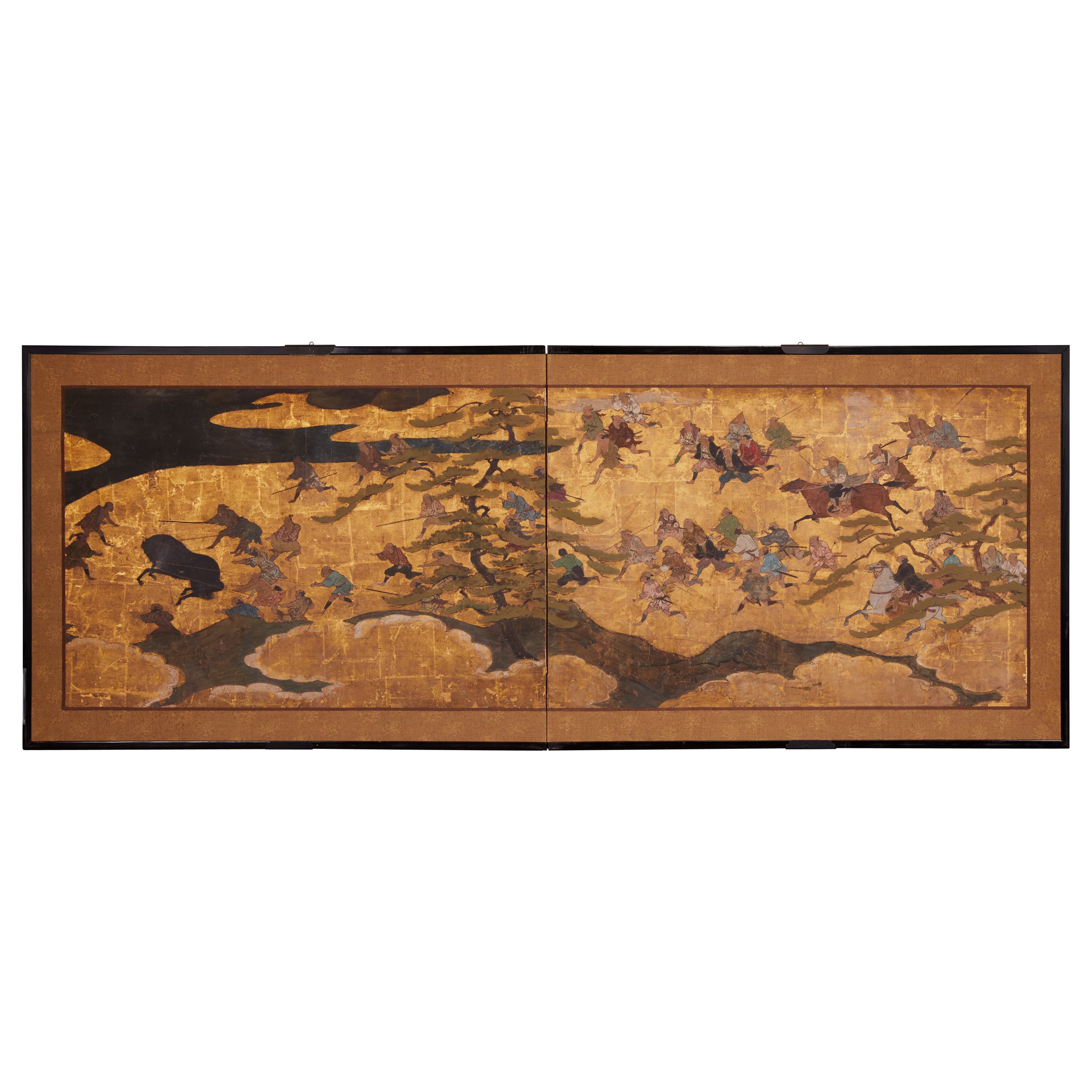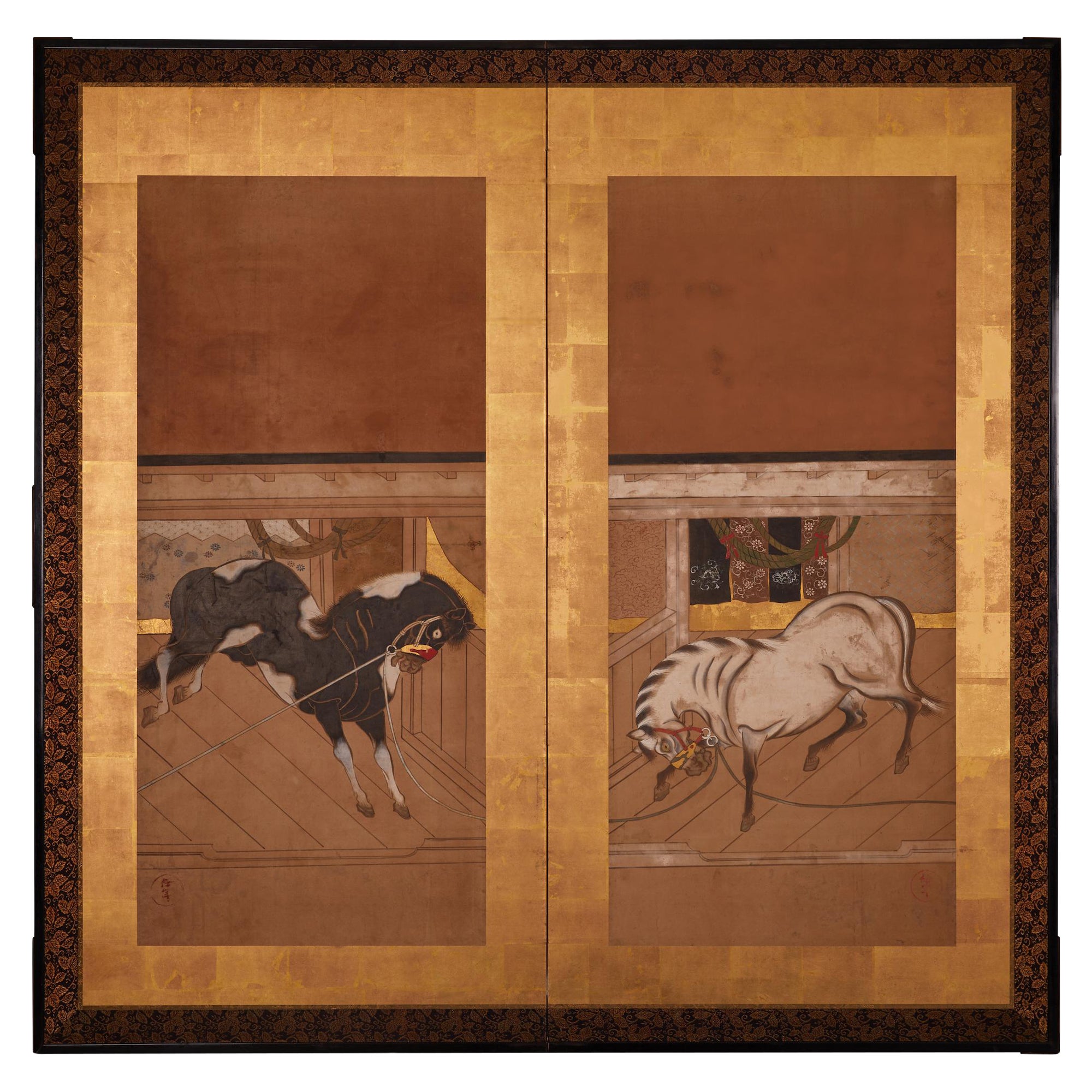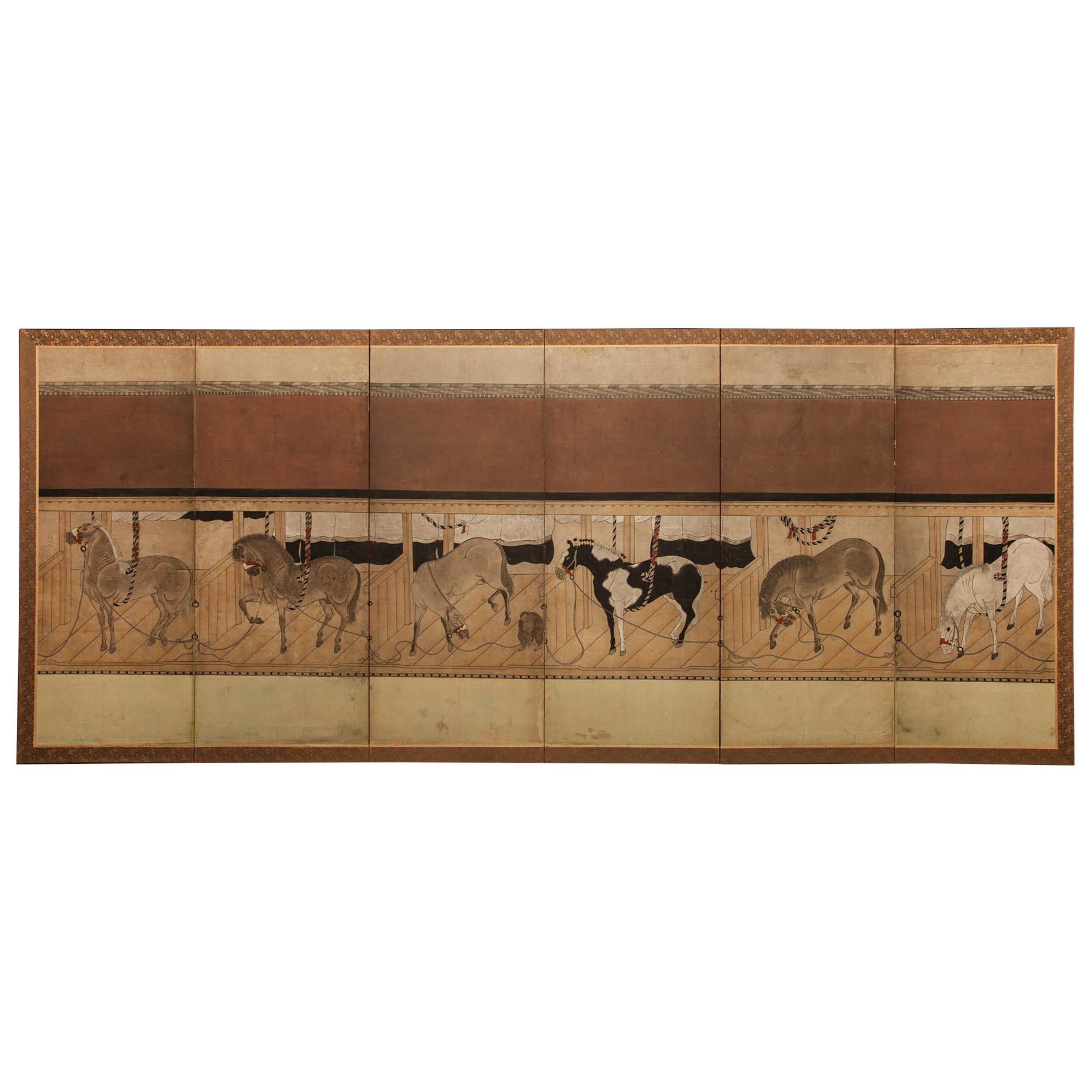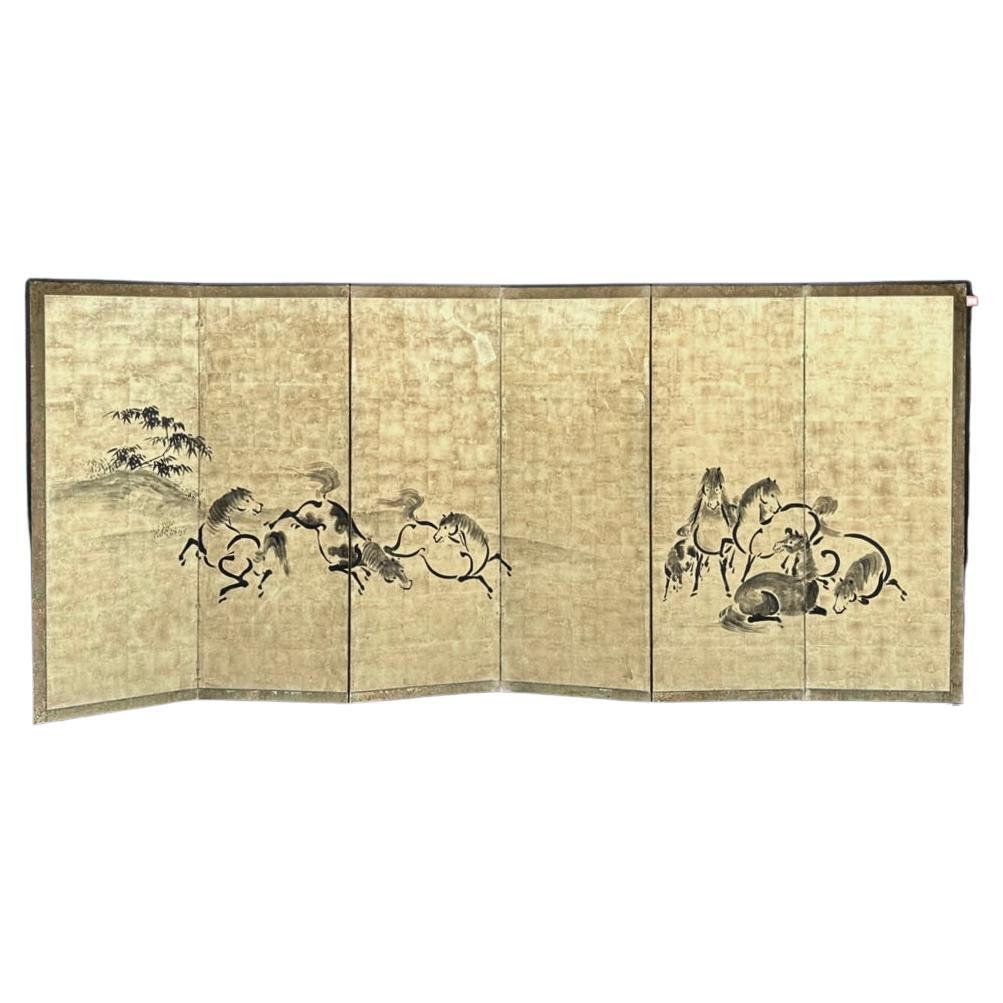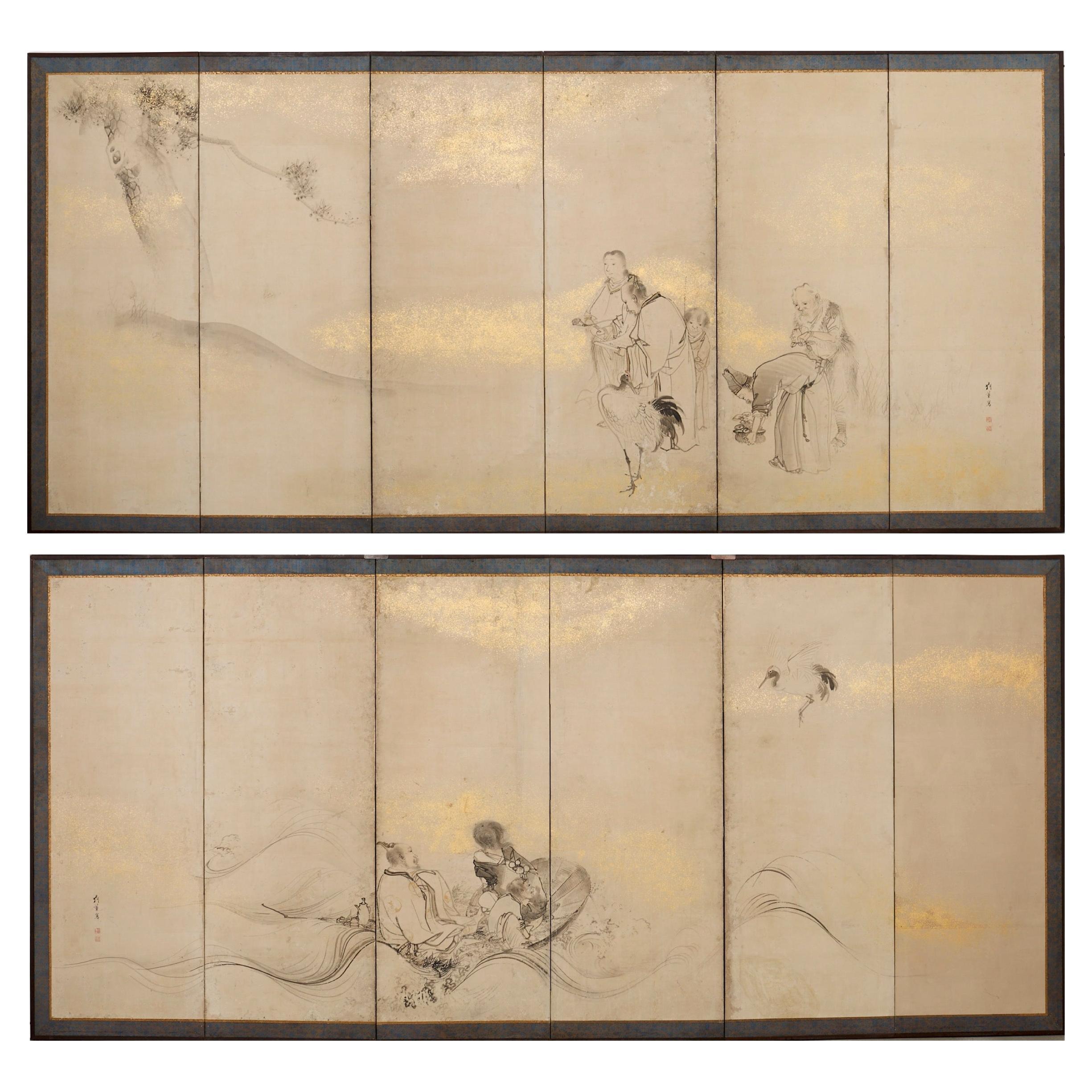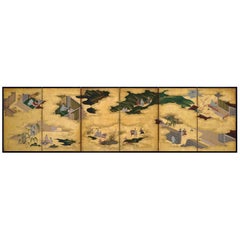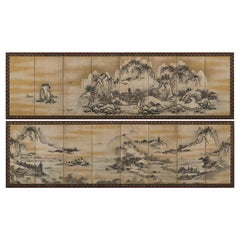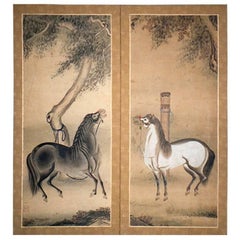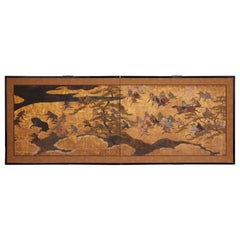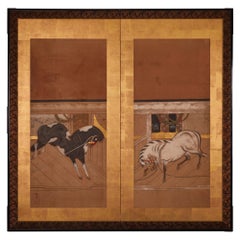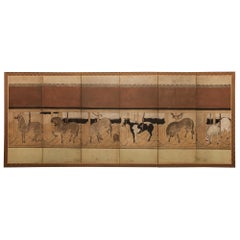Items Similar to Japanese Screen Painting, circa 1700 'Horses' by Kano Tanshin
Want more images or videos?
Request additional images or videos from the seller
1 of 6
Japanese Screen Painting, circa 1700 'Horses' by Kano Tanshin
$18,500
£14,124.67
€16,320.93
CA$25,970.50
A$28,946.83
CHF 15,187.41
MX$353,487.94
NOK 192,305.59
SEK 181,758.03
DKK 121,810.19
About the Item
Horses
Kano Tanshin Morimasa (1653-1718)
Two-panel tea-ceremony Japanese screen or furosaki
Ink on gold leaf,
late 17th-early 18th century
Measures: H 55 cm x W 182 cm
The Kano school was closely aligned with the warrior class in Japan. The samurai, who lived in a closed and rigid hierarchical society established by the Shogunate, were drawn to the energy and freedom horses symbolize; Kano school artists commonly depicted the equine creatures as they are here, in unfettered and carefree family groups. China originally introduced horse paintings to Japan; the works typically focused on capturing the essence of horses in their various environments and often involved integrating human figures into the images.
Kano Tanshin Morimasa (1653-1718) was the son of Kano Tanyu (1602-1674) by his second wife. Tanyu had originally planned for Kano Toun Masanobu to succeed him as head of his Kajibashi Kano branch; the late birth of his son, however, altered that plan. Upon his father’s death in 1674, Tanshin became head of the Kajibashi. He painted in the manner of his father; his work characterized by a light, carefree style, with an exquisite sense of color. Tanshin received the honorary Buddhist title of Hogan (eye of the law) in 1715. This tea-ceremony screen predates that.
- Dimensions:Height: 21.5 in (54.61 cm)Width: 71.5 in (181.61 cm)Depth: 0.75 in (1.91 cm)
- Style:Edo (Of the Period)
- Materials and Techniques:
- Place of Origin:
- Period:1690-1699
- Date of Manufacture:circa 1700
- Condition:Wear consistent with age and use.
- Seller Location:Kyoto, JP
- Reference Number:1stDibs: LU2472319776572
About the Seller
5.0
Recognized Seller
These prestigious sellers are industry leaders and represent the highest echelon for item quality and design.
Established in 2001
1stDibs seller since 2016
70 sales on 1stDibs
Typical response time: 6 hours
- ShippingRetrieving quote...Shipping from: Kyoto, Japan
- Return Policy
Authenticity Guarantee
In the unlikely event there’s an issue with an item’s authenticity, contact us within 1 year for a full refund. DetailsMoney-Back Guarantee
If your item is not as described, is damaged in transit, or does not arrive, contact us within 7 days for a full refund. Details24-Hour Cancellation
You have a 24-hour grace period in which to reconsider your purchase, with no questions asked.Vetted Professional Sellers
Our world-class sellers must adhere to strict standards for service and quality, maintaining the integrity of our listings.Price-Match Guarantee
If you find that a seller listed the same item for a lower price elsewhere, we’ll match it.Trusted Global Delivery
Our best-in-class carrier network provides specialized shipping options worldwide, including custom delivery.More From This Seller
View AllJapanese Screen Painting, Circa 1700 'Tales of Ise' by Tosa Mitsusuke
By Tosa Mitsusuke 1
Located in Kyoto, JP
A six-fold Japanese screen by Tosa Mitsusuke (1675-1710), Japan 17th-18th century, Edo period.
The signature reads Shoroku-i ge Tosa sa Konoe Shogen Mit...
Category
Antique Late 17th Century Japanese Edo Paintings and Screens
Materials
Gold Leaf
17th Century Japanese Screen. View of West Lake by Unkoku Toyo.
Located in Kyoto, JP
Unkoku Toyo (1612-1668)
View of West Lake
Pair of eight-panel Japanese Screens. Ink and gold wash on paper.
Dimensions: Each screen: H. 110 cm x W. 372 cm (43” x 147”)
This pair ...
Category
Antique Mid-17th Century Japanese Edo Paintings and Screens
Materials
Paper
Japanese Painting, 17th Century, Tale of Genji, Fujibakama, Tosa School
Located in Kyoto, JP
Purple Trousers (Fujibakama), Illustration to Chapter 30 of the Tale of Genji (Genji Monogatari)
Tosa School (second half of the 17th century)
Ink, ...
Category
Antique Late 17th Century Japanese Edo Paintings and Screens
Materials
Gold Leaf
17th Century Japanese Screen Pair. Tiger & Dragon by Kaiho Yusetsu
Located in Kyoto, JP
Kaiho Yusetsu (1598-1677)
Tiger and Dragon
Early Edo Period, Circa 1650
A Pair of Six-fold Japanese Screens. Ink and slight color on paper.
Dimensions:
Each screen: H. 171 cm x W. 380 cm (67.5’’ x 149.5’’)
In this pair of early Edo period Japanese screens a group of tigers prowl in a bamboo grove whipped with fierce wind, while a dragon claws through clouds and mist. The dragon embodies elemental qualities - looming out of the mist, the coils of its body disappearing in the clouds. The dragon is calling for rain, symbolizing spring which is considered the fountain of life. On the other side, the tigers calls for the wind, symbolizing autumn which is considered the end of life. Tigers were familiar motifs within Japanese art from ancient times though the animals were imaginary to the people in the 17th century. While dragons and tigers are usually associated as sacred and ferocious, in this painting, both animals have rather amusing expressions. The tigers appear to glare at the dragon with cat-like eyes, and the look on the swirling dragon’s face appears almost affectionate - lending a playful flair to an otherwise magnificent theme.
The tiger and dragon are cosmological symbols of the balancing forces in the world. Screens such as this were originally meant to express the fluctuating nature of the world. For Japanese in the early Edo period, they likely suggested the powers of the cosmos. In Japan the tiger and dragon motif was originally absorbed into the circles of Zen monasteries before spreading into the secular world. The theme especially appealed to the military classes with the Kano school, the official painters to the Shogun and the samurai, being the leading contributors. The painter of this pair of screens, Kaiho Yusetsu (1598-1677), was closely patronized by the third Shogun Tokugawa Iemitsu. In his later years he worked with Kano school artists...
Category
Antique Mid-17th Century Japanese Edo Paintings and Screens
Materials
Silk, Wood, Paper
Japanese Screen Pair, Tigers by Kishi Renzan, Late Edo Period
Located in Kyoto, JP
Kishi Renzan (1804-1859)
Tigers
Pair of six-panel Japanese screens.
Ink and gold-leaf on paper.
In this monochromatic pair of six-fold Japanese screens painted on gold-leaf, Kishi Renzan has created a breathtaking composition of a family of tigers. The screens are filled with a sense of drama which is conveyed by both the subject matter and the wet, expressive brushwork. The running mountain stream and the towering waterfall allude to refreshment during the summer months and we feel the tiger families familiarity and security within their environment. Renzan’s master, Kishi Ganku...
Category
Antique Mid-19th Century Asian Edo Paintings and Screens
Materials
Gold Leaf
Japanese Painting, 17th Century, Tale of Genji, Tosa School
Located in Kyoto, JP
Illustration to an unidentified chapter of the Tale of Genji (Genji Monogatari)
Tosa School (second half of the 17th Century)
Ink, pigment, gofun and...
Category
Antique Late 17th Century Japanese Edo Paintings and Screens
Materials
Gold Leaf
You May Also Like
Japanese Screen Painting of Stallions
Located in Hudson, NY
Japanese two panel screen: Painting of stallions.
Kano school of painting.
Mineral pigments on mulberry paper.
Category
Antique 19th Century Japanese Paintings and Screens
Japanese Two Panel Screen: Horse Roundup
Located in Hudson, NY
Interesting and unusual subject matter, Tosa School painting in mineral pigments on gold leaf with silk brocade border.
Category
Antique Late 17th Century Japanese Paintings and Screens
Materials
Gold Leaf
Japanese Two Panel Screen: Horses in Stable
Located in Hudson, NY
A pair of captivating black and white horses, believed to define hard work and power in Japanese mythology, are beautifully rendered in this painting of mineral pigments on mulberry ...
Category
Antique Early 19th Century Japanese Paintings and Screens
Materials
Bronze, Gold Leaf
Japanese Six-Panel Screen Horses in Stable
Located in Hudson, NY
Kano School painting of horses in stabile, with a monkey. Mineral pigments on mulberry paper with silk brocade border.
Category
Antique Late 18th Century Japanese Edo Paintings and Screens
Materials
Silk, Wood, Paper
Elegant Horse Screen. In style of Kano Tanshin
By Kano Tanshin
Located in Fukuoka, JP
Ink on gold.
This continuation of equine grace unfolds across a stunning gold-leaf backdrop, capturing the essence of nobility that horses represent in Japanese lore.
The screen de...
Category
Antique Late 18th Century Japanese Edo Paintings and Screens
Materials
Gold Leaf
Pair of 18th Century Japanese Edo Screens of Chinese Immortals
Located in Rio Vista, CA
Mesmerizing pair of late 18th/early 19th century Japanese Edo period byobu screens by Shibata Gito (Japanese 1780-1819). The paintings depict Chinese immortals in a dreamy landscape....
Category
Antique 18th Century Japanese Edo Paintings and Screens
Materials
Silk, Wood, Paper
More Ways To Browse
Antique Lacquer Painting
Hand Painted Japanese Screen
Chinese Japanese Screens
Japanese Warrior
Antique Hand Painted Japanese China
Japanese Screen Gold Leaf
17th Century Horse
Gold Chinese Screen
Warrior Horse
18th Century Hand Screen
Tea Screen
Antique Japanese Lacquer Screens
Edo Screen Gold
Kano School
17th Century Japanese Paintings
18th Century Japanese Screens
18th Century Chinese Screen
Japanese Kano Screen
